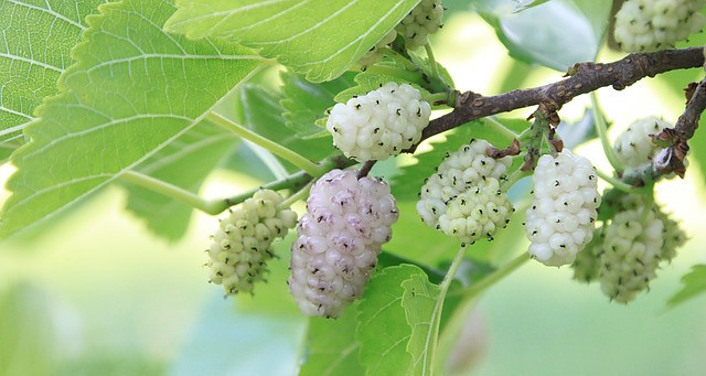
History of white Muberry, cultivated in China for over 5,000 years, the white mulberry spread to Japan and northern India. It then traveled west along the Silk Road: China – Central Asia – Iran – Asia Minor (Turkey) – Europe and the Mediterranean. Caravans would have sold plants to trading posts in the Levant (eastern Mediterranean) such as Bysance (Istanbul), Antioch or Alexandria (Egypt). There, the Genoese and Venetians would have bought them, along with spices and precious fabrics from the Far East, which they then resold in Europe.
Mulberries are the superfruits of the white mulberry tree, Morus alba by its Latin name. The fruit of this tree, the white mulberry, is naturally sweet, even when dried in the shade.
Morus alba has been cultivated in China for over 5,000 years. It has now spread to Japan and northern India.
Mulberries are very popular in Asia and the Middle East. This popularity is due not only to its taste, but also to its distinctive texture.
But it is traditionally recommended for its nutritional qualities.
1-Therapeutic Effects of Mulberries:
Therapeutic Effects of Mulberries:
– Rich in fiber, facilitates intestinal transit
– Rich in antioxidants for cardiovascular health & boosting immunity
– Rich in flavonoids, protects against bacterial infections and cancer
– Slows white hair growth
– Rich in iron to maintain physical and mental performance
– Blood Purification & Detoxification
– Stimulates sexual function
– Fat Burning Food
2- White Blackberry Taste
Its mild, sweet flavor is pleasant and makes it easy to eat.
The fruit of the white mulberry tree, native to Asia or the Middle East, mulberries are known for their high energy value.
Just one tablespoon of mulberries a day is enough to reap the benefits.
Mulberries are now competing with goji berries, but the benefits of these two “superfruits” are complementary.
Mulberries are the fruit of the white mulberry tree (Morus alba in Latin). This tree belongs to the Moraceae family (the same family as the fig tree). It originated in China, where it was cultivated for its leaves, the exclusive food of the silkworm (Bombix caterpillar).
3- When Do Blackberries Ripen?
In the northern hemisphere, blackberries ripen in early summer (June-July). They can reach the size of a child’s thumb. Their color is milky white with pinkish purple hues. Not to be confused with blackberries (wild mulberries), which tend to be black or dark gray-brown.
How to Plant a White Mulberry Tree.
A mulberry adapts to any type of soil. It likes the moisture of fine-grained soils where more than 50% of the dry weight consists of particles smaller than 0.075 mm, when the soil is fresh and better for the mulberry.
You can grow this plant in your own backyard, in a pot on your balcony or in your garden. The lifespan of this tree is between 100 and 150 years, at which age you do not need to take care of it.
4- How to take white mulberry?
The white mulberry is an organic fruit. It can be eaten pure or combined with other organic products (dried fruits, berries, etc.). On the market it is available raw, dried, in jelly or syrup. They can be served as an aperitif, added to cereals or eaten alone.
Rich in fiber, they facilitate and support intestinal transit. They have antioxidant properties that reduce cellular aging and contain flavonoids that help protect against diabetes, bacterial infections and cancer.
White Mulberry Leaf Benefits
White mulberry leaves help to balance diabetes, help stabilize high blood pressure and balance cholesterol levels in the blood, mulberry leaves help in the treatment of cancer.
Thanks to their anthocyanins, blueberries, blackberries, goji berries and acai berries delay cognitive brain aging and mental decline.
Conclusion
Blackberries are the superfruits of the white mulberry tree, Morus alba from its Latin name. The fruit of this tree, the white mulberry, is naturally sweet, even when dried in the shade.
Morus alba has been cultivated in China for more than 5,000 years. It has now spread to Japan and northern India.
Always choose a brand you know and read the label carefully.

4 responses to “White Mulberry Benefits”
I didn’t know we could grow this plant in our garden and even on our balcony.
Thank you for this article.
Yes you can, thank you for your comment.
I didn’t know it either.
Ah ok like Loulou!